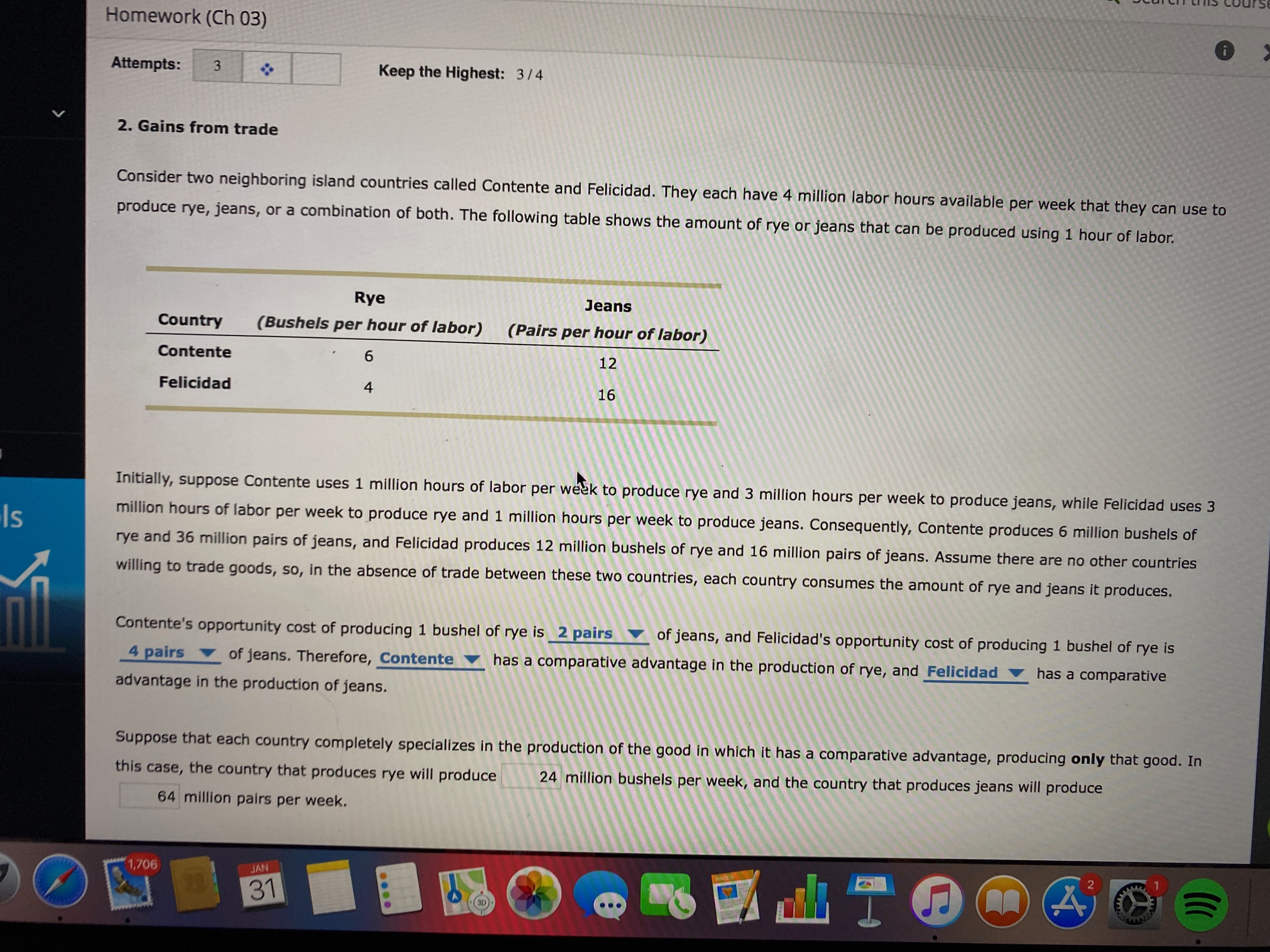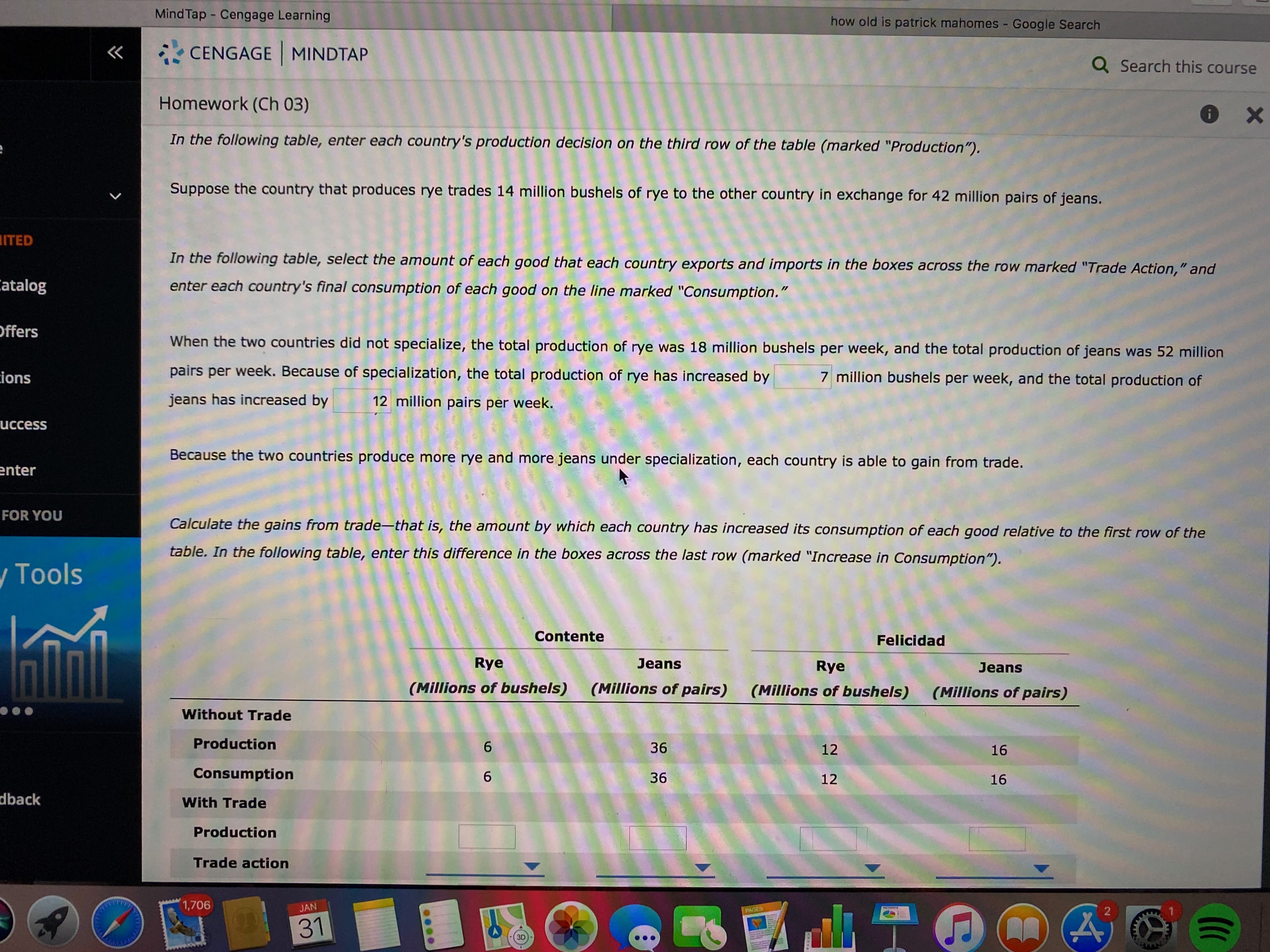Homework (Ch 03) Attempts: Keep the Highest: 3/4 2. Gains from trade Consider two neighboring island countries called Contente and Felicidad. They each have 4 million labor hours available per week that they can use to produce rye, jeans, or a combination of both. The following table shows the amount of rye or jeans that can be produced using 1 hour of labor. Rye Jeans Country (Bushels per hour of labor) (Pairs per hour of labor) Contente 6. 12 Felicidad 16 Initially, suppose Contente uses 1 million hours of labor per week to produce rye and 3 million hours per week to produce jeans, while Felicidad uses 3 million hours of labor per week to produce rye and 1 million hours per week to produce jeans. Consequently, Contente produces 6 million bushels of Is rye and 36 million pairs of jeans, and Felicidad produces 12 million bushels of rye and 16 million pairs of jeans. Assume there are no other countries willing to trade goods, so, in the absence of trade between these two countries, each country consumes the amount of rye and jeans it produces. Contente's opportunity cost of producing 1 bushel of rye is 2 pairs of jeans, and Felicidad's opportunity cost of producing 1 bushel of rye is 4 pairs of jeans. Therefore, Contente has a comparative advantage in the production of rye, and Felicidad ▼ has a comparative advantage in the production of jeans. Suppose that each country completely specializes in the production of the good in which it has a comparative advantage, producing only that good. In this case, the country that produces rye will produce 24 million bushels per week, and the country that produces jeans will produce 64 million pairs per week. 1,706 JAN 31 Mind Tap Cengage Learning how old is patrick mahomes - Google Search CENGAGE MINDTAP Q Search this course Homework (Ch 03) In the following table, enter each country's production decision on the third row of the table (marked "Production"). Suppose the country that produces rye trades 14 million bushels of rye to the other country in exchange for 42 million pairs of jeans. ITED In the following table, select the amount of each good that each country exports and imports in the boxes across the row marked "Trade Action," and enter each country's final consumption of each good on the line marked "Consumption." atalog Offers When the two countries did not specialize, the total production of rye was 18 million bushels per week, and the total production of jeans was 52 million pairs per week. Because of specialization, the total production of rye has increased by 7 million bushels per week, and the total production of ions jeans has increased by 12 million pairs per week. uccess Because the two countries produce more rye and more jeans under specialization, each country is able to gain from trade. enter FOR YOU Calculate the gains from trade-that is, the amount by which each country has increased its consumption of each good relative to the first row of the table. In the following table, enter this difference in the boxes across the last row (marked "Increase in Consumption"). yTools Contente Felicidad Rye Jeans Rye Jeans (Millions of bushels) (Millions of pairs) (Millions of bushels) (Millions of pairs) Without Trade Production 36 12 16 Consumption 6. 36 12 16 dback With Trade Production Trade action 1,706 JAN 2 PAGES 31 3D 6.
Homework (Ch 03) Attempts: Keep the Highest: 3/4 2. Gains from trade Consider two neighboring island countries called Contente and Felicidad. They each have 4 million labor hours available per week that they can use to produce rye, jeans, or a combination of both. The following table shows the amount of rye or jeans that can be produced using 1 hour of labor. Rye Jeans Country (Bushels per hour of labor) (Pairs per hour of labor) Contente 6. 12 Felicidad 16 Initially, suppose Contente uses 1 million hours of labor per week to produce rye and 3 million hours per week to produce jeans, while Felicidad uses 3 million hours of labor per week to produce rye and 1 million hours per week to produce jeans. Consequently, Contente produces 6 million bushels of Is rye and 36 million pairs of jeans, and Felicidad produces 12 million bushels of rye and 16 million pairs of jeans. Assume there are no other countries willing to trade goods, so, in the absence of trade between these two countries, each country consumes the amount of rye and jeans it produces. Contente's opportunity cost of producing 1 bushel of rye is 2 pairs of jeans, and Felicidad's opportunity cost of producing 1 bushel of rye is 4 pairs of jeans. Therefore, Contente has a comparative advantage in the production of rye, and Felicidad ▼ has a comparative advantage in the production of jeans. Suppose that each country completely specializes in the production of the good in which it has a comparative advantage, producing only that good. In this case, the country that produces rye will produce 24 million bushels per week, and the country that produces jeans will produce 64 million pairs per week. 1,706 JAN 31 Mind Tap Cengage Learning how old is patrick mahomes - Google Search CENGAGE MINDTAP Q Search this course Homework (Ch 03) In the following table, enter each country's production decision on the third row of the table (marked "Production"). Suppose the country that produces rye trades 14 million bushels of rye to the other country in exchange for 42 million pairs of jeans. ITED In the following table, select the amount of each good that each country exports and imports in the boxes across the row marked "Trade Action," and enter each country's final consumption of each good on the line marked "Consumption." atalog Offers When the two countries did not specialize, the total production of rye was 18 million bushels per week, and the total production of jeans was 52 million pairs per week. Because of specialization, the total production of rye has increased by 7 million bushels per week, and the total production of ions jeans has increased by 12 million pairs per week. uccess Because the two countries produce more rye and more jeans under specialization, each country is able to gain from trade. enter FOR YOU Calculate the gains from trade-that is, the amount by which each country has increased its consumption of each good relative to the first row of the table. In the following table, enter this difference in the boxes across the last row (marked "Increase in Consumption"). yTools Contente Felicidad Rye Jeans Rye Jeans (Millions of bushels) (Millions of pairs) (Millions of bushels) (Millions of pairs) Without Trade Production 36 12 16 Consumption 6. 36 12 16 dback With Trade Production Trade action 1,706 JAN 2 PAGES 31 3D 6.
Principles of Economics 2e
2nd Edition
ISBN:9781947172364
Author:Steven A. Greenlaw; David Shapiro
Publisher:Steven A. Greenlaw; David Shapiro
Chapter33: International Trade
Section: Chapter Questions
Problem 6SCQ: Table 33.15 shows how the average costs of production for semiconductors (the chips In computer...
Related questions
Question

Transcribed Image Text:Homework (Ch 03)
Attempts:
Keep the Highest: 3/4
2. Gains from trade
Consider two neighboring island countries called Contente and Felicidad. They each have 4 million labor hours available per week that they can use to
produce rye, jeans, or a combination of both. The following table shows the amount of rye or jeans that can be produced using 1 hour of labor.
Rye
Jeans
Country
(Bushels per hour of labor)
(Pairs per hour of labor)
Contente
6.
12
Felicidad
16
Initially, suppose Contente uses 1 million hours of labor per week to produce rye and 3 million hours per week to produce jeans, while Felicidad uses 3
million hours of labor per week to produce rye and 1 million hours per week to produce jeans. Consequently, Contente produces 6 million bushels of
Is
rye and 36 million pairs of jeans, and Felicidad produces 12 million bushels of rye and 16 million pairs of jeans. Assume there are no other countries
willing to trade goods, so, in the absence of trade between these two countries, each country consumes the amount of rye and jeans it produces.
Contente's opportunity cost of producing 1 bushel of rye is 2 pairs
of jeans, and Felicidad's opportunity cost of producing 1 bushel of rye is
4 pairs
of jeans. Therefore, Contente
has a comparative advantage in the production of rye, and Felicidad ▼ has a comparative
advantage in the production of jeans.
Suppose that each country completely specializes in the production of the good in which it has a comparative advantage, producing only that good. In
this case, the country that produces rye will produce
24 million bushels per week, and the country that produces jeans will produce
64 million pairs per week.
1,706
JAN
31

Transcribed Image Text:Mind Tap Cengage Learning
how old is patrick mahomes - Google Search
CENGAGE MINDTAP
Q Search this course
Homework (Ch 03)
In the following table, enter each country's production decision on the third row of the table (marked "Production").
Suppose the country that produces rye trades 14 million bushels of rye to the other country in exchange for 42 million pairs of jeans.
ITED
In the following table, select the amount of each good that each country exports and imports in the boxes across the row marked "Trade Action," and
enter each country's final consumption of each good on the line marked "Consumption."
atalog
Offers
When the two countries did not specialize, the total production of rye was 18 million bushels per week, and the total production of jeans was 52 million
pairs per week. Because of specialization, the total production of rye has increased by
7 million bushels per week, and the total production of
ions
jeans has increased by
12 million pairs per week.
uccess
Because the two countries produce more rye and more jeans under specialization, each country is able to gain from trade.
enter
FOR YOU
Calculate the gains from trade-that is, the amount by which each country has increased its consumption of each good relative to the first row of the
table. In the following table, enter this difference in the boxes across the last row (marked "Increase in Consumption").
yTools
Contente
Felicidad
Rye
Jeans
Rye
Jeans
(Millions of bushels)
(Millions of pairs)
(Millions of bushels)
(Millions of pairs)
Without Trade
Production
36
12
16
Consumption
6.
36
12
16
dback
With Trade
Production
Trade action
1,706
JAN
2
PAGES
31
3D
6.
Expert Solution
This question has been solved!
Explore an expertly crafted, step-by-step solution for a thorough understanding of key concepts.
This is a popular solution!
Trending now
This is a popular solution!
Step by step
Solved in 3 steps with 3 images

Recommended textbooks for you

Principles of Economics 2e
Economics
ISBN:
9781947172364
Author:
Steven A. Greenlaw; David Shapiro
Publisher:
OpenStax

Essentials of Economics (MindTap Course List)
Economics
ISBN:
9781337091992
Author:
N. Gregory Mankiw
Publisher:
Cengage Learning

Brief Principles of Macroeconomics (MindTap Cours…
Economics
ISBN:
9781337091985
Author:
N. Gregory Mankiw
Publisher:
Cengage Learning

Principles of Economics 2e
Economics
ISBN:
9781947172364
Author:
Steven A. Greenlaw; David Shapiro
Publisher:
OpenStax

Essentials of Economics (MindTap Course List)
Economics
ISBN:
9781337091992
Author:
N. Gregory Mankiw
Publisher:
Cengage Learning

Brief Principles of Macroeconomics (MindTap Cours…
Economics
ISBN:
9781337091985
Author:
N. Gregory Mankiw
Publisher:
Cengage Learning